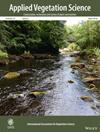Testing for priority effects of tree plantings on natural regeneration in restoration sites in the Brazilian Atlantic Forest
Abstract
Questions
Our study aims to understand whether priority effects or environmental filters drive community assembly in 20-year-old restoration areas in the Brazilian Atlantic Forest. For this, we investigated the following questions: (i) does the initial composition of planted communities (distinct combination of ecological groups) affect the natural regeneration regarding functional composition (mean trait values), diversity (functional and taxonomic), and vegetation structure? (ii) Which functional traits of the planted community have the potential to promote or constrain natural regeneration?
Location
The study was carried out in the Poço das Antas Biological Reserve, located in Rio de Janeiro state, Brazil, in a stand of 2.16 hectares with an experimental restoration design established in the year 2000 to test tree species performance of different ecological groups.
Methods
In 2020, we sampled trees with a diameter at breast height greater than 2.5 cm in 20 m × 20 m plots with four replicates per treatment and measured leaf, wood, and seed functional traits. Then, we estimated the diversity (functional and taxonomic richness), functional composition, and vegetation structure of natural regeneration, compared them between treatments, and tested which traits of the planted community influenced them.
Results
Natural regeneration exhibited significant differences between treatments, particularly regarding the diversity dimension (functional and taxonomic) and vegetation structure (basal area and abundance). Wood density, leaf phosphorus content, and leaf C:N ratio of the planted species were associated with natural regeneration (functional composition, diversity, and vegetation structure).
Conclusions
Priority effects in conservative tree planting communities affect natural regeneration, while functional convergence observed in acquisitive planting communities suggests the role of environmental filtering. Communities with low wood density, low C:N ratio, and high specific leaf area, which characterize an acquisitive resource-use strategy, exhibited higher functional and taxonomic diversity of natural regeneration, leading to the desired trajectory in ecological restoration.

 求助内容:
求助内容: 应助结果提醒方式:
应助结果提醒方式:


